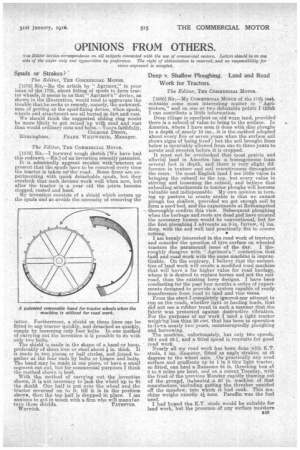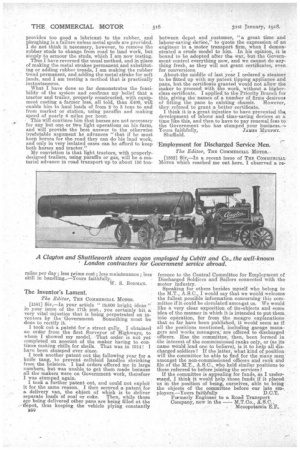OPINIONS FROM OTHERS.
Page 21

Page 22

If you've noticed an error in this article please click here to report it so we can fix it.
!ens Editor invites correspondence on all subjects connected with the use of commercial sectors. Letters should be On one side of the paper only and typewritten by preference. The right of abbreviation is reserved, and no responsibility for views expressed is accepted.
Spuds or Shakes?
The Editor, THE COMMERCIAL MOTOR.
[078] Sir,—Ite the article by " Agrimot," in your issue of the 17th, about fitting of spuds to farm tractor wheels, it seems to us that Agrimet's " device, as shown in the illustration, would tend to aggravate the trouble that he seeks to remedy, namely, the awkwardness of getting at the spud-fixing device, when spuds, wheels and attachment are all buried in dirt and rust.
We should. think the suggested sliding ring would be More likely to get seized "up with mud and rust than would ordinary nuts and bolts.—Youra faithfully, Birmingham. FRANK WrarrwoRam, Manager.
The Editor, THE CoMMEnciAL MorroR_
[1579] Sir,—I forward rough sketch [We have had this redrawn.—En.] of an invention recently patented. It is admittedly atgreat trouble withqractors at present that the spuds have to be removed every tune the tractor is taken on' the road. Some firms are experimenting with quick detachable spuds, but they overlook that such devices work well when new, but after the tractor is a year old the joints become clogged, rusted and bent.
My invention consists of a shield which covers up the spuds and so avoids the necessity of removing the
latter. Furthermore, a shield on these lines can be fitted to any tractor quickly, and detached as quickly,
simply by loosening only four bolts. In one method of carrying out the invention it is possible to do with only two bolts,
The shield is made in the shape of a band -or hoop, preferably of sheet, iron or steel about in. thick. It is made in two pieces or hall circles and jeined together at the four ends by bolts or hinges and bolts Theband may be made in one piece, or have a small segment cut out, but for 'commercial purposes I think the method shown is best.
With the method of carrying out the inventian shown, it is not necessary to Jack the 'wheel up to fit the shield. One half is put over the wheel and. the tractor reversed on to it, till it is in the position shown, 'then the top half is dropped in place. I am anxious to gat in touch with a, firm who will manufao ture these shields. PATENTEE. Warwick.
Deep v. Shallow Ploughing. Land and Road Work for Tractors.
Tire Editor, THE COMMERCIAL MOTOR.
[1580] Sir,—My COMMERCIAL Morey, of the 17th inst.
• contains some most interesting matter re " Agrimotors," and on one or two debatable points I think I can contribute a little information.
Deep tillage is excellent on old worn land, provided there is a subsoil of value to bring to the surface. In America, where I have seen it done with disc ploughs to a depth of nearly 16 ins., it is the method adopted about every five (kr seven years when the surface soil shows signs of being tired ; but the soil brought from below is invariably allowed from one to three years to aerate and sweeten before it is cropped.
It must not be overlooked that most prairie and alluvial land in America has a homogeneous loam several feet in depth, and there is very slight differenee in texture and soil retentiveness throughout the mass. On most English land I see little value in bringing the subsoil to the top, but every value in 'stirring and loosening the subsoil, and belie_ve that subsoiling attachments to tractor ploughs will become valuable and indispensable. My own opinion in turning up pasture to create arable is that we cannot plough too shallow, provided we get enough soil to form a seed bed, and the experiments at Rothampsted thoroughly confirm this view. Subsequent ploughing when the herbage and roots are dead and have created the necessary humus would be conventional, but for the first ploughing I advocate an 8-in. furrow, 41 ins. deep, with the sod well laid practically flat to ensure
rotting. •
I am keenly interested in the road work of tractors,• and consider the question of tyre surface on wheeled tractors the patamount issue of the day. I theroughly disagree with " Agrimot's " contention that land and road work with the same machine is impracticable. On the Contrary,' I believe that the necessities of land work will create a modified road machine that will have a far higher value for road haulage, where it is desired to replace horses and not the railroad, than the existing lorry designs. I have been conducting for the past four months a series of experiments designed to provide a system capable of ready transference from road to land and vice versa.
From the start.lcompletely ignored, any attempt to run on the roads, whether light or hauling loads, that did not use a rubber tread in such a manner that the fabric was protected against destructive vibration. Far the purposes of my work I used a light tractor weigh'ng less than 30 cwt. that has been in operation in4owa nearly two years, uninterruptedly ploughing and harrowing.
The machine, unfortunately, has only two speeds, 224 and 42-1, and a third speed is requisite for good road work.
Nearly all my road work has been done with K.T. studs, 4 ins. diameter, fitted as angle strakes, at 45 degrees to the wheel axis. On practically any road surface and gradients up to 1 in 8 this light tractor, so fitted can haul a Ransome 64 in. threshing box at 3 to 6 miles per hour, and on a recent Tuesday, with the frost of the previous Monday rapidly thawing out of the groupd i
, ita hauled a 60 n, machine of that manufacture, 'including getting the thresher unaided off the meadow, into which it had sunk. This machine weighs exactly 4 tons. Paraffin was the fuel used. I had hoped theK.T. studs would be suitable for land work, but the presence of any surface moisture
provides too good a lubricant to the rubber, and ploughing is a failure unless metal spuds are provided. I do not think it necessary, however, to remove the rubber studs to change from road to land work, but simply to armour the studs, which I am now testing.
Thus I have reversed the usual method, and in place of making the metal strakes permanent and substituting or adding rubber treads, I am making the rubber tread permanent, and adding the metal strake for soft lands, and I am testing -a, method that is practically instantaneous.
What I have done so far demonstrates the feasibility of the system and confirms my belief that a tractor and trailer, properly constructed, with equipment costing a farmer less, all told, than 2400, will enable him to haul loads of from 2 to 3 tons to and from marketor station, using paraffin and making speed of nearly. 6 miles per hour.
• This will convince him that horses are not necessary for any but one or two light operations on his -farm, and will provide the best answer to the otherwise irrefutable argument he advances " that, if he must keep horses for the road they can do his land work, and only in very isolated cases can he afford to keep both horses and tractor."
My conviction is that light tractors, with properlydesigned trailers, using paraffin or gas, will be a material advance in road transport up to about 150 ton
miles per day ; less prime cost ; less maintenance ; less skill in handling. .—Yours faithfully, W. S. BODMAN.
The Inventor's Lament.
The Editor, THE COMMERCIAL MOTOR. • [15p31] Sir,—In your article " 19,000 bright, ideas ", in your issue of the 17th inst., you certainly hit a very vital injustice that is being perpetrated on inventors by the -Government. Something must be
done to rectify it. • I took out a patent for a street gully. I obtained an order from the first Surveyor of Highways, to whom I showed my model. -That order is not yet completed on account of the maker having to continue making chills for shells. That was in 1914! -have been stumped ever since. I took another patent out the following year for a knife tang, to prevent celluloid handles shrinking from the bolsters. I had orders offered me in large numbers, but was unable to get them made because all the makers were on Government work, therefore I was stumped again.
I took a further patent out, and could not exploit it for the same reason. I then secured a patent for a delivery van, the object of which is to deliver separate loads of coal or coke. Then, while those are being delivered other pans are being filled at the -----6epot, thus keeping the vehicle plying constantly g between depot and customer, "a great time and labour-saving device," to quote the expression of an engineer in a motor transport firm, when I demonstrated a crude model to him. In his opinion, it is bound to be adopted after the war, but the Government control everything now' and we cannot do anything fresh, as they will not grant certificates, even for conversions.
About-the middle of last. year I ordered a steamer to be fitted up with my patent tipping appliance and pans, but the certificate granted would not allow the maker to proceed with the work, without a higherclass eertificate. I applied to the Priority Branch for this giving the names of a number of firms desirous of fitting the pans to existing chassis. However, they refused to grant a better certificate. I think it is a great injustice to have prevented tha, development of labour and time-saving devices at a time like this, and then to have to pay renewal fees to the Government who has stumped your business.—:.
Yours faithfully, hams 31p-uPuv. Sheffield.
'Employment for Discharged Service Men,
The Editor, THE COMMERCIAL MOTOR.
[1582) Sir,—In a, recent issue of Tin COmmEacral, MOTOR which reached me out here, I observed a re
ference to the Central Committee for Employment of Discharged Soldiers and Sailors connected with the motor industry.
Speaking for others besides myself who belong to the M.T., A.S.C., I would say that we would welcome the fullest possible information concerning this committee if it could be circulated amongst us. We would like a very clear exposition of its objects and some idea of the manner in which it is intended to put them into operation, for from the meagre explanations that so far have been published, it would seem as if all the positions mentioned, including garage managers and works managers; are offered to discharged officers. Has the committee, then, been formed in the interest of the commissioned ranks only, or (as its name would lead -one to believe), is it to help all discharged soldiers ? If the latter, what kind of position will the committee be able to find for the many men' amongst the non-commissioned officers and rank and file of the 11.T., A.S.C.,who held similar positions to those referred to before joining the services?
If the committee is appealing for funds, as I understand, I think it would help those funds if it placed. us in the position of being, ourselves, able to bring the objects of the committee before our late ein ployers.—Yours faithfully D.O.T.
Formerly Engineer to a Road Transport Company, now in the --M.T.Co., A. S.C.
Mesopotamia E.F.
























